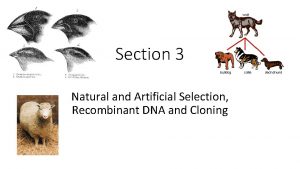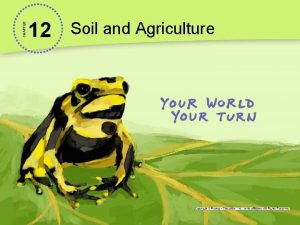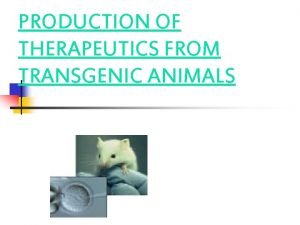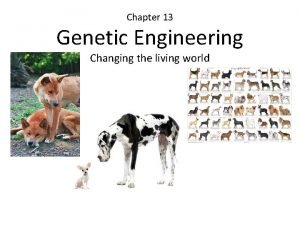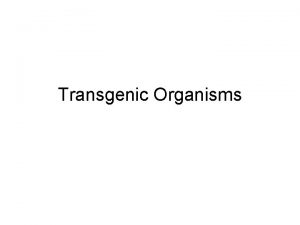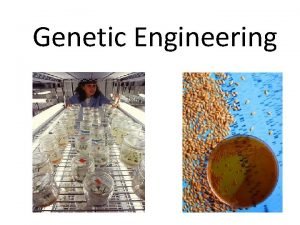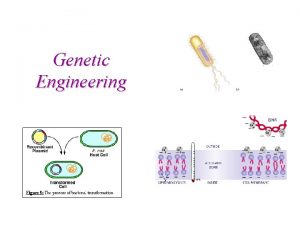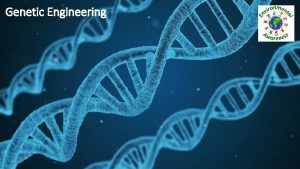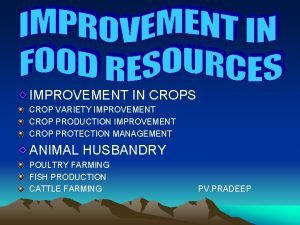Transgenic plants Genetic Engineering for crop improvement Dr














- Slides: 14

Transgenic plants- Genetic Engineering for crop improvement Dr. Divya Menon K Assistant Professor Department of Botany St. Mary’s College Thrissur

APPLICATION A. RESISTANCE TO BIOTIC STRESSES Described in 3 major categories- v Insect Resistance v Virus resistance v Fungal and bacterial disease resistance Transgenic plants, Dr. Divya Menon k, St. Mary’s College

B- Resistance to abiotic stress v. Herbicide resistance: Strategies for engineering herbicide resistance: 1. Overexpression of target protein: target protein- acted by hericidelarge quantities- effect nullified. - we can use strong promoters. 2. Improved plant detoxification: Conversion of toxic herbi- non toxic/less toxic. 3. Detoxification- foreign gene 4. Mutation of the target protein- affected by herbicide- without loosing its function. Transgenic plants, Dr. Divya Menon k, St. Mary’s College

Application 3: Improvement of crop yield and quality Quality of crop- nutritional composition of edible parts, flavor, processing quality, shelf life. Green Revolution: Led by Borlaug, MS Swaminathan 20 th century- genetically improved crops. - rice and wheat-eg Genetic Eng. – extended shelf-life of fruits: Delay in fruit ripening- extended shelf-life, long transport easy, slow ripening- more flavor. Transgenic plants, Dr. Divya Menon k, St. Mary’s College

Application 3: Improvement of crop yield and quality continues… Biochemical changes- ripening- More ethylene, lycopene is synthesized, softened by cell wall degrading enzyme- PG (polygalactouronase). Inhibition of ethylene- reduce ripening. Genetic manipulations of fruit ripening: Antisense RNA approach. Flavr Savr Tomato-Calgene comp, USA. Steps- PG gene isolate, trangfer to vector bacteria, - comple DNAmolecules. - into fresh tomato- transgenic plant- comple DNA- antisense m. RNA molecules. - hybridization with sense m. RNA. - ripening delayed. Transgenic plants, Dr. Divya Menon k, St. Mary’s College

Manipulation of Ethylene biosynthesis: 3 different strategies to block Ethylene biosynthesis: 1. Antisense gene of ACC oxidase: 97% reduced. 2. Antisense gene of ACC synthase: 99. 5% ereduction Insertion of ACC deaminase gene: acts on ACC – 90% redeuction. Gen. Eng to prevent discolouration: - mainly due to oxidation of phenols to quinones- catalyzed- by – polyphenol oxidases- enzymesmitochondria nad chloroplast. Genetic approach- inhibit polyphenol oxidase. Transgenic plants, Dr. Divya Menon k, St. Mary’s College

Gen. Eng for Flower pigmentation: Manipulation of anthocyanin pathway enzyme- most flowers lack blue- absence of flavonoids 3’, 5’hydroxylase- delphinidine 3 glucoside. Introduce gene encoding- delphinidine 3 glucoside. Gen. Eng for male sterility: Sterility- using mitochondrial mutated gene- enzyme ribonuclease- barnase amyloliquefaciuens- transferred to tobacco. Transgenic plants, Dr. Divya Menon k, St. Mary’s College gene- Bacillus

Application 4: Transgenic plants with improved Nutrition Amino acids of seed storage proteins- out of 20 - 10 are essential and other 10 - body synthesis. rice, wheat, corn- EAAs, gram- rich in lysine. 1. Overproduction of lysine by deregulation: Transgenic crops- improve the essential amino acids-. 4 essential- lysine, methionine, threonine, and isoleucine produced from non –essential- aspartic acid. Lysine controlled by feed back inhibition of asartokinase(AK) and dihydrodipicolinate synthase (dhdps). Over produce ltsine by abolishinf feedback. Transgenic plants, Dr. Divya Menon k, St. Mary’s College

Transfer of genes- methionine rich proteins: In sunflower- seed albumin- 16% methionine- these gnes introduced into crops- maize, soyabean etc. Production of lysine-rich glycinin in rice: In humans serum cholesterol lower. Construction of artificial genes – proteins rich in EAAs: synthetic protein- 13% methionine residues. Transgenic plants, Dr. Divya Menon k, St. Mary’s College

Golden Rice: The provitamin A Enriched Rice: Millet rice- drficit in Beta-carotene, the provitamin A. – Genetically modify rice- Beta – carotene- in rice endosermcharacteristic yellow/orange volour- therefore the Golden Rice. It required to introduce 3 genes- encoding enzymes phytotene synthase, carotene desaturase and lycopene Beta – cyclase. 7 years for the same. Transgenic plants, Dr. Divya Menon k, St. Mary’s College

Application 5 Commercial Transgenic crops v. The ultimate aim of GM crops are: Resistance to diseases Improved Nitrogen fixing Higher yielding capacity Resistance to drought ans soil salinity Better nutritiona properties Improved storage quality Transgenic plants, Dr. Divya Menon k, St. Mary’s College

Application 6 Transgenic Plants as bioreactors v. Plants- used as cheap chemical factories v. Transfer right genes- serve as bioreactors of proteins, plastics, pharmacueticals. v. Improvement of nutrient quality-Introduce genes v. Improvement of seed protein quality- transgene protein containing Sulphur was introduced into pea plant. v. Diagnostic and therapeutic proteins: - metabolites – introduced eg- monoclonal antibodies, peptide hormones. v. The use of plants for commercial production of antibodiesplantibodies- a novel approach in biotech. Transgenic plants, Dr. Divya Menon k, St. Mary’s College

v. Edible vaccine making: incorporation of plasmid carrying the antigen gene and antibiotic resistant gene into bacterial cells. (Agrobacterium tumifaciens). The antibiotic resistant pieces of potato leaf- callus- - plant. v. Biodegradable plastics: Transgenic plants- factories- genetically engineered Arabdiopsis- PHB globules in chloroplast- eg in Populus. v. Molecular Breeding: Breeding methods coupled with genetic engineering tech. molecular marker- desired trait- linkage analysisimportant aspect of mol. breeding programme. Transgenic plants, Dr. Divya Menon k, St. Mary’s College

REFERENCE v. Maarten J Chrispeels and D E Sadava. Plants, Genes and Agriculture. Jones and Bartlett Publishers. Transgenic plants, Dr. Divya Menon k, St. Mary’s College
 Illinois crop improvement association
Illinois crop improvement association Biotechnology in crop improvement
Biotechnology in crop improvement Founders effect
Founders effect Genetic programming vs genetic algorithm
Genetic programming vs genetic algorithm Genetic programming vs genetic algorithm
Genetic programming vs genetic algorithm Gene flow vs genetic drift
Gene flow vs genetic drift Genetic drift vs genetic flow
Genetic drift vs genetic flow Define transgenic organisms
Define transgenic organisms Transgenic organisms examples
Transgenic organisms examples Possible transgenic maize in oaxaca mexico
Possible transgenic maize in oaxaca mexico Transgenic bacteria
Transgenic bacteria Transgenic bacteria
Transgenic bacteria Transgenic
Transgenic Production of insulin
Production of insulin Section 13-1 changing the living world
Section 13-1 changing the living world








